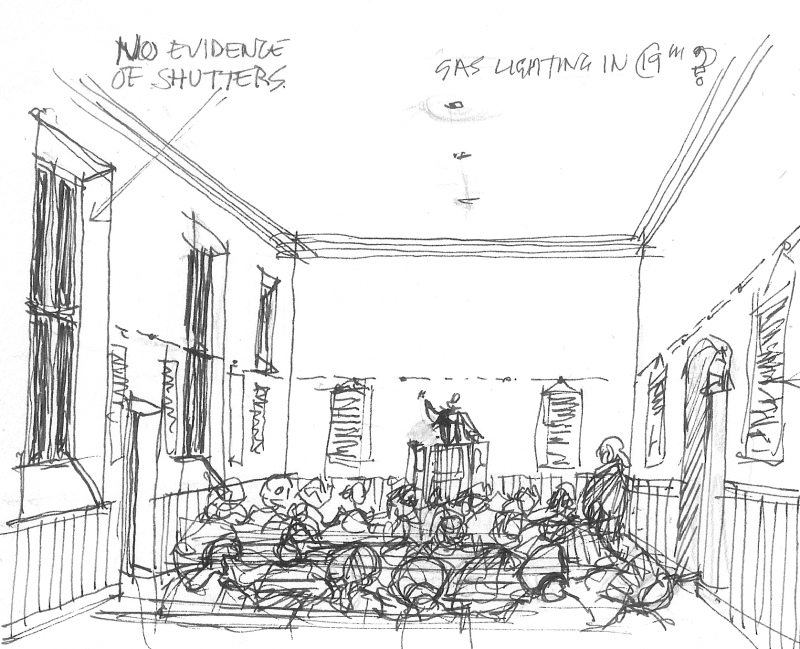
SANDEMANIAN CHAPEL
Faraday House,
The 18th century saw the rise of many small
non-conformist religious groups and sects were active in
James Allen was sent
by Ingham to observe the Sandemanians in Scotland in 1761 (followers of Robert
Sandeman, previously a follower of John Glass, born Perth, Scotland 29 April
1718, died Danbury, Connecticut 2 April 1771). James was converted to the
Sandemanian alternative beliefs. Returning to his hometown of Gayle, near Hawes,
James started a Sandemanian group in the former Inghamite chapel, built in 1755.[2]
This can still be seen today with the burial ground and was later used as
the Village Institute.
It
is recorded that on 9 May 1761, it was ‘agreed that Thos. Shepherd should
purchase a barn at Kirkby Stephen and have it repaired for a convenient meeting
house.
‘James
Allen preached for the first time at this new Sandemanian chapel Sunday evening
17 May
1761.’
[3]
James
was a highly regarded persuasive public speaker and a prolific hymn writer. By
1763, it is documented, that Allen had Sandemanian churches in Gayle with 8
members, at Newby with
Sandemanian,
like Glassite (John Glas followers), was based on early Christianity as
practised by the first century Christians adhering to the instructions of
Today,
the building is named Faraday House after the Faraday family connection. Richard
Faraday, (1757-1815), married Mary Hastwell of Kirkby Stephen Parish by licence
on 20 January 1777.[5]
Richard had seven children, two houses, a carding mill and a close, named
Mill Close, adjoining the mill dam. This is on the site of today’s Low Mill
wood yard. The mill was converted in 1858 by William Hutchinson, son of
carpenter and Wheelwright into a sawmill. The mill remained in the Faraday
family until 1879 when sold by D. Faraday. It is after this locally respected
family that
Richard’s
younger brother was James Faraday, (8 May 1761 – 1810), married to Margaret
Hastwell, (1764-1838), in 1786. They were also Sandemanians. James was a
blacksmith in Outhgill, Mallerstang, where the old Post Office was until
closure. James, with failing health and his wife Margaret pregnant, moved to
The Sandemanians had a reputation as an unorthodox
church with peculiar practices. Michael Faraday said, “a very small and
despised sect of Christians”. However, this is largely undeserved as they
lived out a quietly devout Christian life based on early Christian principles.
There is a small burial ground at the rear of the
chapel but the records for these burials have long been lost.
After
the Sandemanians, the chapel was used by a string of non-conformist and
independent religious groups including the Baptists until the Congregational
Church, outgrew the chapel with over 100 members. They built a new church
costing £1,750, almost opposite in
The
old chapel served for a time as a stocking knitting factory. The traditional
tongue and groove half-panelled walls have been retained. Faraday House is used
today as storage for Haughey Antiques.
[1] SELL Alan P F,1986. Church Planting-A study of Westmorland Nonconformity, H E Walter Limited
[2] The Cleveland Family History Society hold records.
[3] DINSDALE, 1966. History of the Church and Parish of Gargrave 1966 as quoted by H M Pickles
[4]
SMITH John Howard, 2008. The Perfect Rule of the Christian Religion, A
History of Sandemanianism in the Eighteenth
Century,
[5] RILEY Jane F., 1954. The Hammer and The Anvil- A background to Michael Faraday, Dalesman Publishing Co
[6]
[7] PARKINSON J., Guide to Kirkby Stephen & District, J Parkinson, Kirkby Stephen
[8] Congregational Church Book of the Independent Chapel, Kendal Records Office WDFC/C3/1
The sketch below is by UEHS member Ken Martin. It shows the interior of the chapel as it probably appeared in the 18th century. He notes that gas lighting was probably not installed till the 19th century.
